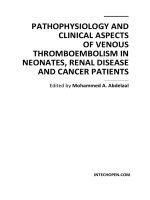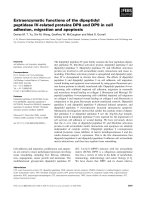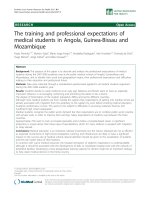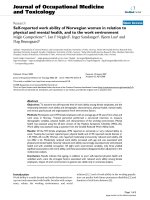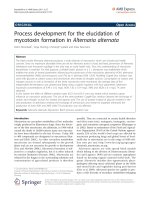Elucidation of the physiologic role of TRIP br2 in cell cycle regulation and cancer pathogenesis
Bạn đang xem bản rút gọn của tài liệu. Xem và tải ngay bản đầy đủ của tài liệu tại đây (25.69 MB, 245 trang )
Elucidation of the
physiologic role of TRIP-Br2
in cell cycle regulation
and cancer pathogenesis
JIT KONG, CHEONG
B.Sc (Hons), NUS
A THESIS SUBMITTED FOR THE
DEGREE OF DOCTOR OF PHILOSOPHY (PhD)
DEPARTMENT OF MEDICINE
YONG LOO LIN SCHOOL OF MEDICINE
NATIONAL UNIVERSITY OF SINGAPORE
2007
Jit Kong, CHEONG Medicine, NUS
Ph.D Thesis 2003-2007
_____________________________________________________________________
2
“Science, the final frontier.
These are the voyages of a nomadic scholar.
Its four-year mission:
To explore strange new worlds,
To seek out new life and new civilizations,
To boldly go where no man has gone before.”
-Jit-
Jit Kong, CHEONG Medicine, NUS
Ph.D Thesis 2003-2007
_____________________________________________________________________
Acknowledgements
I would like to acknowledge the contributions of the following individuals
who have made this work possible.
First and foremost, I thank Dr. Stephen Hsu I-Hong (MD, PhD), to
whom I owe a great debt of gratitude for his enlightening guidance, for his
support and encouragement, and for his invaluable mentorship and friendship.
Without him, my overseas research training stint would never have been a
reality. I also thank my co-mentor, Dr. Manuel Salto-Tellez, for his close
supervision, support and friendship.
I thank my make-shift but reliable thesis advisory committee in Harvard
Medical School, Prof. Joseph V. Bonventre, for his generous support and for
his invaluable guidance, despite of his busy schedule; Dr. Lakshman
Gunaratnam (LG) for his great mentorship and friendship. I hope to share with
others the enthusiasm in scientific discovery that LG has shared with me over
these years. He is the inspirational champion of my 10,000-mile pilgrimage
(LG, you bet I’ll miss those coffee time discussions with you); Dr. Jagesh Shah
for his invaluable discussion; and the great sunshine state professor who was
on sabbatical, Tony, for his guidance and jokes that never failed to brighten
my days at HIM.
I also thank past and present members of Hsu lab and Bonventre lab:
Dr. KG Sim for his induction, guidance and friendship; Dr. Christopher ML
Yang for his guidance, inspiration and friendship (Chris, save some big fishes
for me to catch!); Dr. Zhijiang Zang, Dr. Sharon Thio, Shahidah, Chui Sun,
Chien Tei and Susan L. Nasr for their help and friendships; Dr. Li-li Hsiao for
her friendship and encouragement (Li-li, thanks for everything, you are my
3
Jit Kong, CHEONG Medicine, NUS
Ph.D Thesis 2003-2007
_____________________________________________________________________
base in Boston); Prof Rick Jensen and Dr. Jagdeep Obhrai for their guidance
and collaborations; Dr. Takaharu Ichimura (Hari, nihongo sensei), Dr. Vishal
Vidya, Dr. Ben Humphreys, Dr. Kenneth Christopher (KC), Dr. Mike Ferguson,
Dr. Dirk Henstchel, Dr. Jeremy Duffield, Dr. Masa Mizuno, Dr. Satohiro
Masuda, Dr. Carmen de Lucas, Dr. Catherine Best, Dr. Alice Sheridan, Dr.
Tatiana Besschetnova, Dr. Mike Macnak, Marcella, Savuth, Wendy, Rebekah,
Said and Hakon for their friendships. Special thanks go to Eileen O’Leary and
Xiaoming Sun for nurturing me as if I am one of their own kids in Boston. No
words can express my heartfelt gratitude to all you folks in Boston, I almost
gave up on science but you folks brought me back because you never gave up
on me!
Last but not least, I thank my family and loved ones for their patience
and encouragement throughout my apprenticeship in the States. Dad, Mum,
sisters (Fong/Teng/Ming), brother-in-laws (Danny/HS) and little nephews
(Benji and Arthur), thank you for assuring me from time to time that everything
is fine in Singapore; my beloved better half, Meihui, thank you so much for
your faith in me and staking out everything to stay with me in this long distance
relationship. I’m so sorry for not being there for you on joyous occasions or
when you are feeling weak. You know, without you, I could never have been
able to cross that finishing line and have learnt this much. Thank you,
sweetheart!
Love,
Jit (July 2007)
4
Jit Kong, CHEONG Medicine, NUS
Ph.D Thesis 2003-2007
_____________________________________________________________________
Table of Contents
Table of Contents 5
Abstract 11
List of Figures and Tables 15
Abbreviations 23
Chapter I 24
Literature review 24
1.1 Current paradigm of the cell cycle and cancer 25
1.1.1 The general schema of cell cycle progression: simplifying
complexity 25
1.1.2 The control of cell cycle progression 27
1.1.2.1 RB/E2F/DP-mediated transcriptional regulation of cell cycle
progression 27
1.1.2.2 Cyclin-dependent kinase (CDK)-mediated regulation 31
1.1.3 Substrates of CDK 36
1.1.4 The restriction points and checkpoints that regulate cell cycle
progression: an issue of quality control assurance 37
1.1.5 Dysregulation of the cell cycle in human cancer 41
1.1.5.1 Role of altered cyclin-dependent kinase (CDK) expression and/or
function in human cancer 41
1.1.5.2 Role of altered cyclin expression and/or function in human cancer
42
1.1.5.3 Role of altered Cdc25 expression and/or function in human cancer
44
5
Jit Kong, CHEONG Medicine, NUS
Ph.D Thesis 2003-2007
_____________________________________________________________________
1.1.5.4 Role of altered CDK inhibitor (CKI) expression and/or function in
human cancer 44
1.1.5.5 Role of altered checkpoint protein expression and/or function in
human cancer 46
1.1.5.6 Dysregulation of the RB/E2F/DP transcription pathway in cancer
cell cycle 47
1.2 TRIP-Br: a novel family of PHD zinc finger- and bromodomain-
interacting proteins that regulate E2F-dependent transcription and cell
cycle progression 50
1.2.1 General background of the TRIP-Br family 50
1.2.2 Genomic organization of the TRIP-Br genes 51
1.2.3 Structural and functional homology of TRIP-Br proteins 52
1.2.4 Coactivator function of TRIP-Br proteins 54
1.2.5 Corepressor function of TRIP-Br proteins 58
1.2.6 Other interactors of TRIP-Br proteins 61
1.3 Specific aims of this study 62
1.3.1 Specific Aim 1: To unravel the physiologic role(s) of TRIP-Br2 in cell
cycle regulation by characterizing the phenotype of a TRIP-Br2 knockout
mouse model. 62
1.3.2 Specific Aim 2: To validate the oncogenic potential of TRIP-Br2 in
cancer pathogenesis by stable overexpression of TRIP-Br2 in NIH3T3
mouse fibroblasts and high-throughput immunoscreens of human tumor
tissue microarray to identify TRIP-Br2 overexpression 63
6
Jit Kong, CHEONG Medicine, NUS
Ph.D Thesis 2003-2007
_____________________________________________________________________
1.3.3 Specific Aim 3: To elucidate the regulatory mechanism(s) that
govern the protein turnover of TRIP-Br2 to confer tight regulation of TRIP-
Br2 function during cell cycle progression 64
Chapter II 65
Characterization of a novel TRIP-Br2 knockout mouse model 65
2.1 Methods & Material 66
2.1.1 Generation and characterization of rabbit anti-TRIP-Br2 polyclonal
antibody 66
2.1.2 Generation of TRIP-Br2
+/-
heterozygous founder mice 70
2.1.3 PCR genotyping 73
2.1.4 Histological examination of mouse tissues 73
2.1.5 Preparation of single cell suspension from mouse tissues 74
2.1.6 Preparation of anti-CD3/anti-CD28 pre-coated 96-well plates 75
2.1.7 In vitro T cell proliferation assays 75
2.1.8 Flow cytometric lymphoid cell analysis 76
2.1.9 In silico TRIP-Br2 gene expression profiling 78
2.1.10 Establishment of PMEF cell lines 78
2.1.11 Semi-quantitative RT-PCR analysis 79
2.1.12 Denaturing SDS-PAGE and western blot analyses 82
2.1.13 Serum deprivation, bromodeoxyuridine (BrdU) labeling and flow
cytometric DNA content analysis 82
2.1.14 Colony formation assay 83
2.1.15 Nuclear condensation assay 83
2.1.16 Determination of cell number and viability 84
7
Jit Kong, CHEONG Medicine, NUS
Ph.D Thesis 2003-2007
_____________________________________________________________________
2.2 Results 85
2.2.1 Generation and characterization of rabbit anti-TRIP-Br2 polyclonal
antibody 85
2.2.2 Inactivation of the TRIP-Br2 locus in mice 89
2.2.3 TRIP-Br2, a novel proliferation marker, is highly expressed in
lymphohematopoietic cell lineages 92
2.2.4 Ablation of TRIP-Br2 in splenic T cells and primary embryonic
fibroblasts of mice leads to reduced cell proliferative potential associated
with aberrant cell cycle reentry and defective DNA synthesis 94
2.3 Discussion 109
Chapter III 112
TRIP-Br2 is a novel protooncogene that is aberrantly overexpressed in
human cancers 112
3.1 Materials and Methods 113
3.1.1 Construction of C-terminal HA-tagged hTRIP-Br2 expression
plasmid 113
3.1.2 Cell culture and reagents 116
3.1.3 Generation of cells stably expressing TRIP-Br2 116
3.1.4 Serum deprivation, Bromodeoxyuridine (BrdU) labeling and flow
cytometric DNA content analysis 117
3.1.5 Soft agar colony formation and tumor induction assays 117
3.1.6 Semi-quantitative and real-time quantitative RT-PCR analyses 118
3.1.7 Subcellular fractionation, denaturing SDS-PAGE and Western
blotting 119
8
Jit Kong, CHEONG Medicine, NUS
Ph.D Thesis 2003-2007
_____________________________________________________________________
3.1.8 Tissue microarray (TMA) construction, immunohistochemistry and
immunocytochemistry 119
3.1.9 RNA interference of TRIP-Br2 expression 120
3.1.10 Statistical analysis 121
3.2 Results 122
3.2.1 TRIP-Br2 overexpression transforms murine fibroblasts by
upregulation of E2F/DP-mediated transcription 122
3.2.2 TRIP-Br2 overexpression confers anchorage-independent growth in
soft agar and promotes tumor growth in athymic nude mice 129
3.2.3 TRIP-Br2 is overexpressed in many human cancer cell lines and
tumors 133
3.2.4 TRIP-Br2 overexpression is associated with poor prognosis in HCC
140
3.2.5 RNA interference of TRIP-Br2 expression inhibits cell-autonomous
growth of HCT-116 human colorectal cancer cells 143
3.3 Discussion 146
Chapter IV 149
Nuclear export of TRIP-Br2 is required for its ubiquitin-proteasome-
dependent degradation 149
4.1 Materials and Methods 150
4.1.1 Cell culture, DNA transfection and reagents 150
4.1.2 Cell synchronization and flow cytometric DNA content analysis 151
4.1.3 Semi-quantitative RT-PCR 151
4.1.4 Protein degradation and 26S proteasome inhibition assays 151
4.1.5 Immunoprecipitation and immunocytochemistry 152
9
Jit Kong, CHEONG Medicine, NUS
Ph.D Thesis 2003-2007
_____________________________________________________________________
4.1.6 NES motif prediction analysis and nuclear export inhibition assay
153
4.1.7 Subcellular fractionation, denaturing SDS-PAGE and Western 153
4.2 Results 155
4.2.1 TRIP-Br2 expression is differentially regulated during cell cycle
progression 155
4.2.2 C-terminal HA-tagged TRIP-Br2 is susceptible to rapid turnover . 159
4.2.3 Degradation of TRIP-Br2 through the 26S proteasome-dependent
pathway 162
4.2.4 TRIP-Br2 is post-translationally modified through its association with
ubiquitin 173
4.2.5 Deletion of the TRIP-Br2 C-terminus that includes a putative nuclear
export signal motif inhibits TRIP-Br2 degradation, independent of its
ubiquitination status 176
4.2.6 The putative C-terminal NES motif of TRIP-Br2 regulates access to
26S proteasome in G
2
/M phase 183
4.3 Discussion 191
Conclusion 199
References 203
Appendices 227
10
Jit Kong, CHEONG Medicine, NUS
Ph.D Thesis 2003-2007
_____________________________________________________________________
Abstract
11
Jit Kong, CHEONG Medicine, NUS
Ph.D Thesis 2003-2007
_____________________________________________________________________
The TRIP-Br/SERTAD family of mammalian transcriptional regulators
has recently been cloned and shown to be involved in E2F-mediated cell cycle
progression. We report, herein, further characterization of the least understood
member of TRIP-Br/SERTAD family, TRIP-Br2 (also known as SEI-2 or
SERTAD2). We assessed the role of TRIP-Br2 in development, transcriptional
regulation and cell cycle progression by
inactivating the TRIP-Br2 locus in
mouse through insertional mutagenesis and exon trapping. Ablation of TRIP-
Br2 did not lead to infertility, embryonic lethality or failure of lymphoid
development in mice. TRIP-Br2 expression was found to be significantly
higher in bone marrow and highly proliferative lymphohematopoietic cell
lineages than in other tissues. Splenic T cells, normally highly proliferative in
wild-type mice, were found to be entirely resistant to the growth-promoting
effects of well-known T cell mitogens in TRIP-Br2
-/-
mice. A similar
phenomenon was observed with another highly proliferative cell type, the
primary murine embryonic fibroblasts (PMEFs). Flow cytometric DNA analysis
revealed an increase in the S phase cell population in asynchronously cycling
TRIP-Br2
-/-
PMEFs, which also had a reduced proliferative rate compared to
wild-type PMEFs. Only ~50% of quiescent serum-starved TRIP-Br2
-/-
cells had
reentered the cell cycle in response to serum restimulation. Semi-quantitative
RT-PCR and western blot analyses further revealed that key cell cycle
regulators such as cyclin E, PCNA and CDC2 (or CDK1) were downregulated
in TRIP-Br2
-/-
PMEFs.
Given that the ablation of TRIP-Br2 resulted in a proliferative block, we
postulated that a gain of TRIP-Br2 function may play an important role in
dysregulation of cell proliferation in human tumor formation and cancer. We
12
Jit Kong, CHEONG Medicine, NUS
Ph.D Thesis 2003-2007
_____________________________________________________________________
therefore validated the oncogenic potential of TRIP-Br2 in cancer
pathogenesis. Its overexpression, which was associated with the upregulation
of E2F-mediated transcription, transformed NIH3T3 fibroblasts and promoted
tumor growth in athymic nude mice. We performed high throughput expression
profiling of TRIP-Br2 in multiple human tumor tissue arrays and showed that
TRIP-Br2 is overexpressed in many human cancers. Apart from the
identification and validation of TRIP-Br2 overexpression as a putative novel
mechanism underlying human tumorigenesis, such as the case of
hepatocellular carcinoma, we have also uncovered its potential as a novel
chemotherapeutic drug target. As a proof-of-principle, we showed that the
siRNA knockdown of TRIP-Br2 is sufficient to inhibit cell-autonomous growth
of HCT-116 colorectal cancer cells in vitro.
Since the loss-of- and gain-of-function of TRIP-Br2 are associated with
cell proliferative arrest and tumor development respectively, we investigated
whether spatial and/or temporal regulation of TRIP-Br2 by transcriptional
and/or translational mechanisms may serve to control the precise execution of
its function during cell cycle progression. We demonstrated that TRIP-Br2
protein (not transcript) expression peaks at the G
1
/S boundary and
progressively decreases through S, and G
2
/M phases of the cell cycle. The
oscillatory nature of TRIP-Br2 expression in cell cycle progression was further
shown to be tightly regulated by multiple mechanisms, including the ubiquitin-
proteasome-dependent degradation pathway and the CRM1-mediated nuclear
export pathway. An analysis of TRIP-Br2 truncation mutants revealed that the
acidic carboxyl-terminal region of TRIP-Br2, which includes a putative nuclear
export signal (NES) motif, a PHD zinc finger- and/or bromodomain (PHD-
13
Jit Kong, CHEONG Medicine, NUS
Ph.D Thesis 2003-2007
_____________________________________________________________________
Bromo)-interaction domain and a transcriptional activation domain (TAD), is
required for the regulation of its protein turnover.
14
Jit Kong, CHEONG Medicine, NUS
Ph.D Thesis 2003-2007
_____________________________________________________________________
List of Figures and Tables
Figures
Figure 1. A schematic representation of the mammalian cell cycle 26
Figure 2. The RB/E2F/DP network in mammals and other species. 30
Figure 3. A schematic overview of the key processes in cell cycle regulation 34
Figure 4. Current molecular model for RB/E2F function 49
Figure 5. Genomic organization of TRIP-Br genes 51
Figure 6. Homology of the TRIP-Br family 53
Figure 7. TRIP-Br proteins play a dual function in the regulation of cell cycle
progression during late G
1
and the G
1
/S transition 57
Figure 8. Proposed model for the function of TRIP-Br3/HEPP/CDCA4 in the
regulation of E2F1 and p53 transcriptional activity 60
Figure 9. Antigenicity of human TRIP-Br2 69
Figure 10. Targeted disruption of the TRIP-Br2 locus in mouse 72
Figure 11. Endogenously- and exogenously-expressed hTRIP-Br2 in HEK293
cells were detected by anti-hTRIP-Br2 polyclonal antibodies in G4195 rabbit
serum. 86
Figure 12. Peptide competition assay reveals specificity and cross-reactivity of
rabbit anti-hTRIP-Br2 polyclonal antibodies to their protein targets in mouse
and human cell lysates 88
Figure 13. Validation of TRIP-Br2 ablation in mice 91
15
Jit Kong, CHEONG Medicine, NUS
Ph.D Thesis 2003-2007
_____________________________________________________________________
Figure 14. Splenic T cells of TRIP-Br2-/- adult mice were resistant to Con A- or
anti-CD3/anti-CD28-stimulated proliferation 98
Figure 15A. Validation of TRIP-Br2 ablation in PMEFs. 99
Figure 15B. Reduced DNA synthesis in continually cycling TRIP-Br2
nullizygous mutant PMEFs 100
Figure 15C. Reduced colony forming potential of continually cycling TRIP-Br2
nullizygous mutant PMEFs 101
Figure 16A. The reduction in proliferative potential of TRIP-Br2 mutant PMEFs
is not a result of increased apoptosis. 102
Figure 16B. Key apoptotic markers were not dysregulated in TRIP-Br2
nullizygous mutant PMEFs 103
Figure 16C. Accumulation of S phase cell population in asynchronously
cycling TRIP-Br2 nullizygous mutant PMEFs 104
Figure 17A. Reduced cell cycle reentry potential of TRIP-Br2 nullizygous
mutant PMEFs following their release from serum deprivation. 105
Figure 17B. Accumulation of G
0
/G
1
phase cell population in serum
restimulated TRIP-Br2 nullizygous mutant PMEFs. 106
Figure 17C. Reduced DNA synthesis in serum restimulated TRIP-Br2
nullizygous mutant PMEFs 107
Figure 18. A subset of E2F-responsive genes, including CYCLIN E, was
downregulated in TRIP-Br2 mutant PMEFs. 108
Figure 19. Map of pcDNA3.1-hTRIP-Br2-HA expression plasmid. 115
16
Jit Kong, CHEONG Medicine, NUS
Ph.D Thesis 2003-2007
_____________________________________________________________________
Figure 20A: Generation of NIH3T3 fibroblasts that stably overexpress TRIP-
Br1-HA or TRIP-Br2-HA. 125
Figure 20B: Increased DNA synthesis observed in various serum-deprived
TRIP-Br-overexpressing NIH3T3 clones. 126
Figure 20C: Increased S phase cells observed in various serum-deprived
TRIP-Br-overexpressing NIH3T3 clones. 127
Figure 20D. TRIP-Br2-HA-overexpressing-NIH3T3 fibroblasts proliferate in the
absence of mitogenic stimulation as a result of dysregulation of the
RB/E2F/DP1 transcriptional pathway. 128
Figure 21A. Overexpression of TRIP-Br2-HA confers anchorage-independent
growth on soft agar. 130
Figure 21B. Overexpression of TRIP-Br2-HA induces tumors in nude mice
(nu/nu) 131
Figure 21C. Histological examination of TRIP-Br2-HA overexpression-induced
tumors excised from nude mice (nu/nu). 132
Figure 21D. Biochemical and immunohistochemical examinations of TRIP-Br2-
HA overexpression-induced tumors excised from nude mice (nu/nu). 132
Figure 22A. TRIP-Br2 is aberrantly expressed in many human cancer cell
lines 136
Figure 22B. TRIP-Br2 is a nuclear factor that is overexpressed in cancer cells.137
Figure 22C. TRIP-Br2 is overexpressed and preferentially localized to the
nuclei in cancer cells. 137
Figure 22D. TRIP-Br2 is aberrantly expressed in many human tumors. 138
17
Jit Kong, CHEONG Medicine, NUS
Ph.D Thesis 2003-2007
_____________________________________________________________________
Figure 23. TRIP-Br2 overexpression is associated with poor prognosis in HCC.142
Figure 24A. siRNA knockdown of TRIP-Br2 expression in HCT-116 colorectal
cancer cells. 144
Figure 24B. siRNA knockdown of TRIP-Br2 expression inhibits cell-
autonomous growth of HCT-116 colorectal cancer cells. 145
Figures 25A-B. TRIP-Br2 is differentially expressed during the cell cycle in
U2OS cells. 157
Figure 25C. TRIP-Br2 is differentially expressed during the cell cycle in COS-7
cells 158
Figure 26A-D. Rapid turnover of C-terminal HA-tagged TRIP-Br2. 161
Figure 27A. Inhibition of 26S proteasome activity by MG132 or ALLN stabilized
TRIP-Br2-HA in transfected COS-7 cells. 164
Figure 27B. Inhibition of 26S proteasome activity by MG132 stabilized TRIP-
Br1-HA and TRIP-Br2-HA in NIH3T3 mouse fibroblasts stably overexpressing
TRIP-Br-HA proteins. 166
Figure 27C. Inhibition of 26S proteasome activity by MG132 stabilized TRIP-
Br2-HA in COS-7 cells over time 166
Figure 27D. Inhibition of 26S proteasome activity by MG132 stabilizes TRIP-
Br2 in U2OS cells over time. 167
Figure 27E. Inhibition of 26S proteasome activity by MG132 stabilizes TRIP-
Br2 in G
2
/M phase-COS-7 cells (Western blot). 170
Figure 27F. Inhibition of 26S proteasome by MG132 stabilizes TRIP-Br2 in
G
2
/M phase-COS-7 cells (Immunocytochemistry) 171
18
Jit Kong, CHEONG Medicine, NUS
Ph.D Thesis 2003-2007
_____________________________________________________________________
Figure 27G. TRIP-Br2 in G
2
/M phase-COS-7 cells was stabilized by
proteasome inhibitor MG132 and CRM1-mediated nuclear export inhibitor
LMB 172
Figure 28A. HA-Ubiquitin is associated with GAL4DBD-hTRIP-Br2 174
Figure 28B. GAL4DBD-hTRIP-Br2 is associated with HA-Ubiquitin 175
Figure 29A. Stabilization of TRIP-Br2 by deletion of its C-terminus. 179
Figure 29B. Degradation profile of TRIP-Br2 truncation mutants. 180
Figure 29C. Deletion of the TRIP-Br2 C-terminus abrogated the regulation of
its protein turnover independent of its ubiquitination status 181
Figure 29D. A putative nuclear export signal motif is localized to the C-
terminus of TRIP-Br2. 182
Figure 30A. Subcellular localization of wildtype TRIP-Br2 and its truncation
mutants. 186
Figure 30B. Subcellular fractionation analysis of wildtype TRIP-Br2 and its
truncation mutants 187
Figure 30C. Deletion of the TRIP-Br2 C-terminus stabilized TRIP-Br2 by
nuclear entrapment. 188
Figure 30D. Deletion of the C-terminus of TRIP-Br2, which includes the
putative C-terminal NES of TRIP-Br2, stabilized TRIP-Br2 in G
2
/M phase 189
Figure 30E. Inhibition of nuclear export of TRIP-Br2 by LMB restores its
stability in G
2
/M phase 190
Figure 31. Proposed model of the regulation of TRIP-Br2 during cell cycle
progression 197
19
Jit Kong, CHEONG Medicine, NUS
Ph.D Thesis 2003-2007
_____________________________________________________________________
Figure 32. H&E staining of liver, heart and kidney of 8-week-old 129SvEvBrd-
TRIP-Br2 wildtype and mutant mice 228
Figure 33. H&E staining of colon, small intestines and lung of 8-week-old
129SvEvBrd-TRIP-Br2 wildtype and mutant mice 229
Figure 34. H&E staining of stomach, pancreas and spleen of 8-week-old
129SvEvBrd-TRIP-Br2 wildtype and mutant mice 230
Figure 35. H&E staining of thymus and testis of 8-week-old 129SvEvBrd-TRIP-
Br2 wildtype and mutant mice. 231
Figure 36. H&E staining of liver, heart and kidney of 8-week-old C57BL/6J-
TRIP-Br2 wildtype and mutant mice 232
Figure 37. H&E staining of colon, small intestine, lung, stomach and testis of
8-week-old C57BL/6J-TRIP-Br2 wildtype and mutant mice. 233
Figure 38. H&E staining of spleen and thymus of 8-week-old C57BL/6J-TRIP-
Br2 wildtype and mutant mice. 234
Figure 39. CD8+ cytotoxic T cells and CD4+ helper T cells of TRIP-Br2
wildtype and mutant mice (thymus) 235
Figure 40. CD8+ cytotoxic T cells and CD4+ helper T cells of TRIP-Br2
wildtype and mutant mice (spleen) 236
Figure 41. Proportion of CD4+ memory T cells of TRIP-Br2 wildtype and
mutant mice (spleen) 237
Figure 42. Proportion of CD8+ memory T cells of TRIP-Br2 wildtype and
mutant mice (spleen) 238
20
Jit Kong, CHEONG Medicine, NUS
Ph.D Thesis 2003-2007
_____________________________________________________________________
Figure 43. CD8+ cytotoxic T cells and CD4+ helper T cells of TRIP-Br2
wildtype and mutant mice (lymph nodes). 239
Figure 44. CD4+ memory T cells of TRIP-Br2 wildtype and mutant mice (lymph
nodes). 240
Figure 45. CD8+ memory T cells of TRIP-Br2 wildtype and mutant mice (lymph
nodes). 241
Figure 46. B220+ B cells and CD11c+ dendritic cells of TRIP-Br2 wildtype and
mutant mice (spleen) 242
Figure 47. B220+ B cells and CD11c+ dendritic cells of TRIP-Br2 wildtype and
mutant mice (lymph nodes) 243
Figure 48. CD4+ CD25+ FoxP3+ regulatory T cells of TRIP-Br2 wildtype and
mutant mice (thymus) 244
Figure 49. CD4+ CD25+ FoxP3+ regulatory T cells of TRIP-Br2 wildtype and
mutant mice (lymph nodes) 245
Tables
Table 1. Activation of cyclin-CDK complexes at specific points of the cell cycle. 32
Table 2. Cyclin dependent kinases inhibitors (CKI) bind to CDK alone or the
CDK-cyclin complex and regulate CDK activity 35
Table 3A. Fluorophore-conjugated antibodies used in flow cytometric lymphoid
cell analysis 77
Table 3B. Sequences of gene-specific primers used in semi-quantitative RT-
PCR. 80
Table 3C. Sequences of gene-specific primers used in PCR 81
21
Jit Kong, CHEONG Medicine, NUS
Ph.D Thesis 2003-2007
_____________________________________________________________________
Table 4. TRIP-Br2 expression profiling in human tissues by interrogation of the
Novartis GNF SymAtlas v1.2.4 microarray database. 93
Table 5. Frequency of TRIP-Br2 overexpression in 10 different cancer
malignancies. 139
Table 6. Hepatocellular carcinoma (HCC) patient survival in the presence or
absence of TRIP-Br2 overexpression. 141
22
Jit Kong, CHEONG Medicine, NUS
Ph.D Thesis 2003-2007
_____________________________________________________________________
Abbreviations
TRIP-Br Transcriptional Regulator Interacting with PHD zinc finger-
and/or Bromodomain-containing transcription factors
SERTAD SEI-1, RBT1 and TARA Domain
RB Retinoblastoma protein
CDK Cyclin-dependent kinase
PHD-Bromo Plant Homeodomain-Bromodomain
PMEF Primary Murine Embryonic Fibroblast
SDS-PAGE SDS-Polyacrylamide Gel Electrophoresis
HA Hemagglutinin
DMEM Dulbecco’s Modified Eagle’s Medium
FBS Fetal Bovine Serum
FACS Fluorescence-Activated Cell Sorting
TMA Tissue Microarray
siRNA Small interfering ribonucleic acid
HU Hydroxyurea
Ub Ubiquitin
NLS Nuclear localization signal
NES Nuclear export signal
TAD Transactivation domain
LMB Leptomycin
H&E Hematoxylin and Eosin
23
Jit Kong, CHEONG Medicine, NUS
Ph.D Thesis 2003-2007
_____________________________________________________________________
Chapter I
Literature review
24
Jit Kong, CHEONG Medicine, NUS
Ph.D Thesis 2003-2007
_____________________________________________________________________
1.1 Current paradigm of the cell cycle and cancer
1.1.1 The general schema of cell cycle progression: simplifying
complexity
Cell division is characterized mainly by two consecutive processes,
DNA replication and segregation of replicated chromosomes into two separate
cells. It was originally divided into two stages: mitosis (M), which is the process
of nuclear division; and interphase, the interlude between two M phases
(Figure 1). The stages of mitosis include prophase, metaphase, anaphase and
telophase. Although the interphase cells simply grow in size under microscopic
examination, the complexity of interphase, which further comprises of G
1
, S
and G
2
phases, was not fully appreciated until much later (Norbury and Nurse,
1992). The replication of DNA occurs at a specific time in interphase called S
phase that is preceded by a gap called G
1
during which the cell is preparing for
DNA synthesis. S phase is in turn followed by a gap called G
2
during which the
cell prepares for mitosis. G
1
, S, G
2
and M phases form the subdivisions of
what is known to be the cell cycle today (Figure. 1). Cells in G
1
are capable of
entering a resting state called G
0
prior to their commitment to DNA replication.
Cells in G
0
account for the majority of non-proliferative cells in the human body.
25

